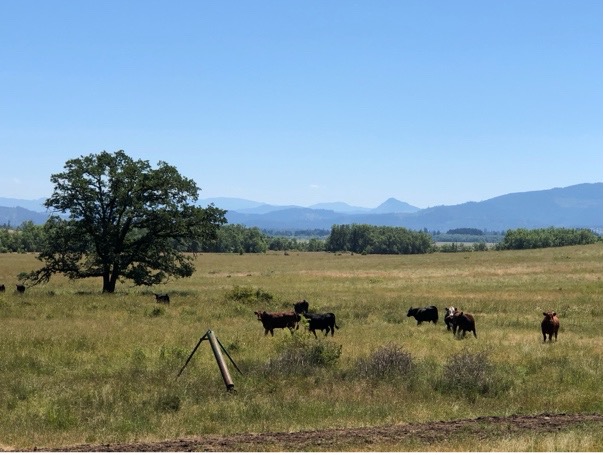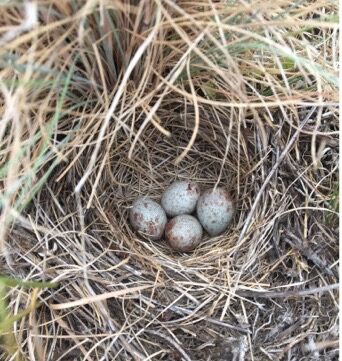
Cows grazing in the pastures at Creswell Oaks. Photo credit: Sara Barker, Cornell Lab
Your eBirding data helps create tools that can be used to further conservation, inspire support, and inform ecological management strategies. eBird in Action is a segment which shares the conservation stories made possible because of your contributions. This edition comes from the Cornell Lab’s Land Trust Bird Conservation Initiative (LTBCI).
“Many folks have hesitance around grazing in a conservation context and have trouble understanding how those two things can go together,” says Elspeth Kim, Director of Partnerships at Ecostudies Institute. Through on-the-ground management, landowner engagement, and bird monitoring, Kim and her partners used funding from a Land Trust Bird Conservation Initiative small grant to demonstrate how sustainable grazing practices can contribute to maintaining habitat conditions for the Oregon Vesper Sparrow (OVSP) and other grassland bird species while supporting agricultural land uses at Creswell Oaks, a 1,600-acre ranch in Eugene, Oregon.
The OVSP is one of three subspecies of Vesper Sparrow recognized by the U.S. Fish and Wildlife Service. According to the Klamath Bird Observatory, populations of OVSPs historically spanned grasslands from southwest British Columbia to northwestern California, but they are now found only in western Oregon and Washington. The subspecies is facing severe habitat loss due to land conversion for agriculture and urban development, with a current population size estimated at fewer than 3,000 individuals. As a result, the American Bird Conservancy petitioned to list the subspecies under the Endangered Species Act in 2017.
Grasslands are critical for biodiversity and ecosystem function, and the OVSP relies on these habitats for nesting and foraging. Their numbers have decreased dramatically over the past few decades, but conservation efforts by organizations such as land trusts that focus on restoring these habitats offer hope for the recovery of not just the OVSP but a range of other species that depend on these ecosystems. Efforts to conserve the OVSP and its habitat help ensure the health of the broader ecosystem, improving the resilience of grassland environments to climate change and other environmental pressures.

Four eggs in an OVSP nest. Photo credit: CNLM
Innovative, collaborative partnerships can provide opportunities to integrate environmental stewardship into working landscapes, showing that agricultural practices can align with conservation goals. According to Kim, who managed this grant project, it was successful “because of landowners who care about their land, and who care about birds.” She says many farmers and ranchers value conservation, and her work is to understand how she and her organization can better support them with technical advice and capacity.
Through this project, the partners worked to demonstrate that grazing, when managed correctly, can replicate natural disturbance processes and maintain the open, grassy landscapes that OVSPs require for successful breeding, thus using management practices like rotational grazing as a conservation tool at Creswell Oaks, which is protected by a conservation easement held by the Center for Natural Lands Management (CNLM).
To support the management that the landowner was already conducting, for the grant project CNLM helped remove trees, brush, and invasive plant species from 15 acres of pastures at Creswell Oaks. Ongoing management includes thinning edges of oak stands, along with brush cutting and herbicide applications of invasive species to create the unique grassland habitat that OVSPs require, with a relatively small component of shrub and tree cover.
To assess the effects of the habitat management on the avian community, and OVSP specifically, an avian monitoring strategy was implemented across the grazed pastures. Gary Slater, Director of Avian Conservation at the Ecostudies Institute, established a monitoring protocol using line transects. In 2019, he surveyed each transect three times during the breeding season, recording all aural and visual detections in eBird. Slater continues to monitor the site annually, recording detections of all birds and noting the type of detection, sex, and perpendicular distance between each bird and the transect.
This monitoring allows for adaptive management, ensuring that conservation practices remain effective as conditions change. Slater says that the property owner and land manager are actively trying to optimize grazing for OVSP benefits, and that with longer-term monitoring, they hope “to identify the sweet spot for grazing and creating OVSP habitat, understanding that it may change every year depending on weather conditions and regional demographics.”
During the course of the grant project, two webinars helped demonstrate effective management strategies to local landowners, conservationists, and the broader community, setting up Creswell Oaks to be a demonstration area for successful OSVP habitat management going forward. These workshops showcased the value of grazing as a habitat management tool and shared hands-on experience in habitat restoration and bird monitoring.
By focusing on habitat restoration, monitoring, and community engagement, this project has already set an effective example for integrating conservation into working landscapes. In summary, Slater says, “This has been an incredible partnership and is a key example of how private lands and sustainable grazing can contribute to avian conservation of common and imperiled bird species.”
Explore the State of the Birds 2025 to learn more about the status of grassland bird species, and log your bird observations on eBird to contribute to science and conservation in your area.
Read more about the small grant project completed by the Center for Natural Lands Management and Ecostudies Institute on the Cornell Lab’s Land Trust Bird Conservation Initiative website.
